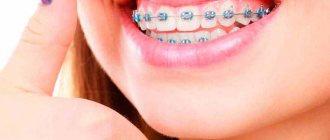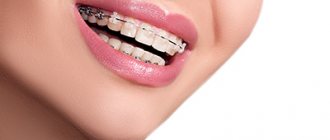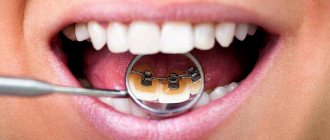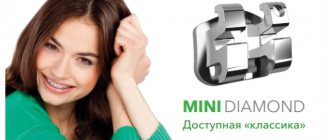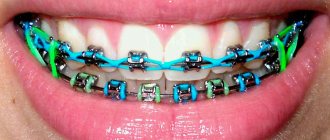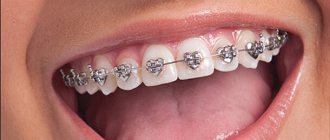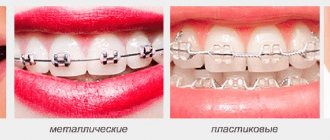How to install braces?
It is impossible to make recommendations remotely and decide which option is better. We offer you a wide range of dental braces, including both classic and innovative designs that are invisible on the teeth. If you decide to get braces, we recommend that you familiarize yourself with the specifications of the various models in more detail. Studying the types of braces and the materials used to make them will allow you to make the best choice.
Braces for the upper and lower teeth
Braces for one row of teeth
Lingual braces
- Diagnostics
- Dental treatment
- Whitening
- Air Flow
- Vector
- Tartar removal
- Fissure sealing
- Deep fluoridation
- Plasmolifting of gums
- Bite correction
- Sealing
- Restoration
- Prosthetics
- Implantation
- Sinus lifting
- Removal of a tooth
- Braces
- Metal
- Lingual
Lingual braces are a worthy, but at the same time more expensive alternative to vestibular structures installed on the front surface of the teeth. Metal braces in the classic design are an arch with fasteners, which affects the entire dentition in the right direction to correct malocclusion and other dentofacial deformities.
Advantages
The main advantage of the lingual system can be considered its aesthetics. Considering the duration of orthodontic treatment, many patients refuse to wear braces at a young age due to fear of being ridiculed and due to psychological discomfort. Late correction usually takes longer, and deciding on it is also not always easy. In such situations, lingual braces are the best option.
Another undeniable advantage of these systems is the possibility of using them for deep bites, which are difficult to correct with the help of vestibular structures.
Flaws
But external camouflage, in addition to high cost, has other disadvantages:
- longer period of getting used to the device (usually does not exceed three weeks);
- more pronounced discomfort that occurs during eating;
- minor changes in diction (mainly associated with the pronunciation of those sounds that are formed when the tongue is pushed away from the teeth; a classic example of a violation of diction when wearing braces can be considered a lisp);
- difficulties in caring for the system (due to location features).
Along with this, there are some difficulties regarding the installation of lingual braces, which is usually carried out using the indirect method, which not only increases the total duration of the doctor’s manipulations, but also requires him to have the necessary professional training.
After the examination, drawing up a treatment plan and carrying out all the necessary studies, in particular, taking x-rays of the patient’s jaws, the dentist proceeds to taking impressions. Impressions of the teeth will serve as the basis for modeling the braces system, which is transferred into the oral cavity in almost complete form.
To simplify such false treatment, special technologies have been developed that involve the use of auxiliary technical equipment. When caring for lingual systems, you should follow the diet prescribed by your doctor and avoid foods with high adhesive properties, as well as foods that are too hard, to prevent the braces from moving.
Recently, individual lingual braces, created for each patient individually, have gained particular popularity. The material used to make them is often an alloy containing gold. Often, doctors also resort to installing flat internal braces, which reduces the risk of speech changes.
Cost of installing braces
| ORD-01 | Course of treatment using a brace system (for the upper and lower dentition): | |
| ORD-1.01 | Treatment with a metal brace system. I degree of severity | 113,000.00 ₽ |
| ORD-1.02 | Treatment with a metal brace system. II degree of severity | 158,200.00 ₽ |
| ORD-1.03 | Treatment with a metal brace system. III degree of severity | 158,200.00 ₽ |
| ORD-1.04 | Aesthetic bracket system: I degree of severity | 70,000.00 ₽ |
| ORD-1.05 | Aesthetic bracket system: II degree of severity | 80,000.00 ₽ |
| ORD-1.06 | Aesthetic bracket system: III degree of severity | 90,000.00 ₽ |
| ORD-1.07 | Self-ligating metal bracket system: I degree of severity | 70,000.00 ₽ |
| ORD-1.08 | Self-ligating metal bracket system: II degree of severity | 80,000.00 ₽ |
| ORD-1.09 | Self-ligating metal bracket system: III degree of severity | 90,000.00 ₽ |
| ORD-1.10 | Self-ligating aesthetic bracket system: I degree of severity | 80,000.00 ₽ |
| ORD-1.11 | Self-ligating aesthetic bracket system: II degree of severity | 90,000.00 ₽ |
| ORD-1.12 | Self-ligating aesthetic bracket system: III degree of severity | 100,000.00 ₽ |
| ORD-1.13 | Lingual braces: Children and teenagers | 90,000.00 ₽ |
| ORD-1.14 | Lingual braces: Adults | 110,000.00 ₽ |
| ORD-1.15 | Technique 2*41 dentition | 33,900.00 ₽ |
| ORD-1.16 | Preparation before orthopedics 1st quadrant | 22,600 ₽ |
| ORD-1.17 | Treatment with a ceramic bracket system. 1st degree of severity | 124,300 ₽ |
| ORD-1.18 | Treatment with a ceramic brace system. 2nd degree of severity | 146,900.00 ₽ |
| ORD-1.19 | Treatment with a ceramic brace system. 3rd degree of severity | 169,500.00 ₽ |
| ORD-1.20 | Treatment with a lingual brace system. 1st degree of severity | 135,600.00 ₽ |
| ORD-1.21 | Treatment with a lingual brace system. 2nd degree of severity. | 158,200.00 ₽ |
| ORD-1.22 | Treatment with a lingual brace system. 3rd degree of severity | 180,800.00 ₽ |
| ORD-1.23 | Observation, activation of the orthodontic apparatus | 1,000.00 ₽ |
| ORD-1.24 | Observation, activation of the orthodontic apparatus | 5,500.00 ₽ |
| ORD-1.25 | Fixation of the braces system on 1 row of teeth. | 15,000.00 ₽ |
| ORD-1.26 | Fixation of 1 metal bracket | 2,260.00 ₽ |
| ORD-1.27 | Fixation of 1 ceramic bracket | 2,830.00 ₽ |
| ORD-1.28 | Fixation of 1 lingual bracket | 3,390.00 ₽ |
| ORD-1.29 | Fixation of the buccal tube | 2,830 ₽ |
| ORD-1.30 | Bracket re-attachment/reposition | 900.00 ₽ |
| ORD-1.31 | Fixation of the orthodontic ring | 2,260.00 ₽ |
| ORD-1.32 | Re-fixation of the orthodontic ring | 570.00 ₽ |
| ORD-1.33 | Fixing the orthodontic button | 1,130.00 ₽ |
| ORD-1.34 | Fitting and applying a metal arc. | 2,260.00 ₽ |
| ORD-1.35 | Fitting and applying an aesthetic arch. | 3,390.00 ₽ |
| ORD-1.36 | Fitting and applying the reversal arc. | 2,830.00 ₽ |
| ORD-1.37 | Making and fixing a palatal clasp. | 5,650.00 ₽ |
| ORD-1.38 | Changing ligatures on 1 row of teeth. | 1,130.00 ₽ |
| ORD-1.39 | Fixation of 1 link of the elastic chain (chain) | 110.00 ₽ |
| ORD-1.40 | Fixation of open/closed spring. | 570.00 ₽ |
| ORD-1.41 | Spring activation. | 230.00 ₽ |
| ORD-1.42 | Fixing the stopper/hook on the arch | 450.00 ₽ |
| ORD-1.43 | Fixation of Kobayashi's ligature/hook | 340.00 ₽ |
| ORD-1.44 | Application of elastic intermaxillary traction. | 570.00 ₽ |
| ORD-1.45 | Occlusal pad | 900.00 ₽ |
| ORD-1.46 | Approximal reduction of enamel in the area of 1 tooth. | 170.00 ₽ |
| ORD-1.47 | Removal of 1 unit of orthodontic appliance, tooth treatment | 570.00 ₽ |
| ORD-1.48 | Selective grinding of 1 tooth | 340.00 ₽ |
| ORD-02 | Course of treatment using a braces system (for one row of teeth): | |
| ORD-2.01 | Metal braces system 1 row of teeth | 25,990.00 ₽ |
| ORD-2.02 | Metal braces system for 2 rows of teeth | 45,200.00 ₽ |
| ORD-2.03 | Metal bracket system: III degree of severity | 67,800.00 ₽ |
| ORD-2.04 | Aesthetic bracket system: I degree of severity | 42,000.00 ₽ |
| ORD-2.05 | Aesthetic bracket system: II degree of severity | 48,000.00 ₽ |
| ORD-2.06 | Aesthetic bracket system: III degree of severity | 54,000.00 ₽ |
| ORD-2.07 | Self-ligating metal bracket system for 1 row of teeth | 23,000.00 ₽ |
| ORD-2.08 | Self-ligating metal bracket system for 2 rows of teeth | 40,000.00 ₽ |
| ORD-2.09 | Self-ligating metal bracket system: III degree of severity | 54,000.00 ₽ |
| ORD-2.10 | Self-ligating aesthetic bracket system: I degree of severity | 48,000.00 ₽ |
| ORD-2.11 | Self-ligating aesthetic bracket system: II degree of severity | 54,000.00 ₽ |
| ORD-2.12 | Self-ligating aesthetic bracket system: III degree of severity | 60,000.00 ₽ |
| ORD-2.13 | Lingual braces system for 1 row of teeth. | 85,000.00 ₽ |
| ORD-2.14 | Lingual braces system for 2 rows of teeth | 135,000.00 ₽ |
| ORD-2.15 | Ceramic bracket system 1 row of teeth | 28,250.00 ₽ |
| ORD-2.16 | Ceramic bracket system for 2 rows of teeth | 50,850.00 ₽ |
| ORD-2.17 | Self-ligating ceramic bracket system for 2 rows of teeth | 56,500.00 ₽ |
| ORD-2.18 | Self-ligating ceramic bracket system 1 row of teeth | 28,250.00 ₽ |
| ORD-2.19 | Self-ligating combined bracket system. | 50,850.00 ₽ |
Make an appointment
What kind of braces can be installed?
- Lingual invisible, fixed on the inside of the teeth;
- Vestibular (external), installed on the front surface of the teeth.
- Metal braces are a vestibular-type design; they are clearly visible on the teeth, and it is impossible to hide the orthodontist’s treatment from others.
- Ceramic braces are very durable and almost invisible structures on the vestibular surface of the teeth, which allow you to quickly correct your bite.
- Sapphire systems are a way to turn a corrective structure into a spectacular dental decoration.
- The Damon line of braces is a safer alternative to metal and ceramics, and is also highly aesthetic.
- Lingual braces called Incognito.
Types of braces systems
- passive;
- self-ligating active;
- non-ligating (self-ligating).
Indications for braces therapy
- Crowding (close proximity) of several teeth in a row.
- A deep bite in which the upper teeth strongly overlap the lower teeth.
- Excessive development of the upper or lower jaw.
- Crossbite.
- Gaps between teeth.
- Dystopia (crooked teeth)
Contraindications
- Caries.
- Defects in tooth enamel (chalky spots, cracks).
- Artificial crowns and multiple fillings.
- Allergic reactions to the materials from which structures are made
- Mental and severe somatic illnesses
Put braces on your teeth
- The procedure for installing braces has several stages:
- Preparatory.
- Fixation of orthodontic rings and cheek locks.
- Fixation of staples (braces) to the tooth surface using a direct or indirect method.
- Fastening the orthodontic arch (ligature or non-ligature method).
Our specialists
Yurov Ruslan Viktorovich
Orthopedic dentist, chief physician, 15 years of experience. Higher education, Ryazan State Medical University named after. ak. I.P. Pavlova 2003 VSB 0164569, Diploma of professional retraining 2005, PP No. 797856, certificate of specialist in orthopedic dentistry No. 0177180227431, certificate of specialist in therapeutic dentistry No. 0377240101365.
Miroshnikov Oleg Vladimirovich
Orthopedic dentist, 18 years of experience. Higher education, Moscow State Medical and Dental University named after. Evdokimova 2000 DVS 0015762, residency (d. No. 366) in orthopedic dentistry, certificate of specialist in orthopedic dentistry No. 0177180232429, certificate of advanced training No. 180000239261, certificate of specialist in surgical dentistry No. 017724 0013993
DO YOU HAVE ANY QUESTIONS OR ARE YOU READY TO MAKE AN APPOINTMENT?
Leave your phone number and our manager will contact you in 10 minutes
Installation of braces
Treatment method: braces system.
You can move your teeth!
Any orthodontic treatment is based on this immutable principle. No matter how complex the dental problem may be (bad bite, large gaps between the teeth or, conversely, too close together), our orthodontist will select a braces system that will move this problem - in the literal sense of the word. Orthodontic treatment has no age restrictions. The “teenage” reputation of braces is 100% due to the fact that the age of 7-13 years is the most optimal for correction: all permanent teeth are actively changing or have just erupted - this is the peak of jaw growth, so treatment is more effective. The teeth have not yet had time to linger in their incorrect position, so it is easier to change it. An ideal situation is when a child is seen by an orthodontist from the beginning of the change of baby teeth, and the doctor, if necessary, selects appropriate corrective devices (alignments, plates or braces).
By the age of 14-16, jaw growth ends. The treatment method—the brace system—remains; only the treatment tactics change. The duration of treatment practically does not depend on age, but depends, first of all, on the complexity of the problem.
How is the treatment carried out?
1. Consultation
During the consultation, you meet the doctor and discuss all your concerns. An experienced doctor, as a rule, only needs an examination to draw basic conclusions. He will talk about how the treatment will be carried out, announce its estimated duration and cost. If you are satisfied with everything, the doctor will prescribe a diagnosis to confirm preliminary conclusions and draw up a detailed treatment plan.
2. Diagnostics
The required scope of diagnostic procedures includes: a general dental image (OPG) or a three-dimensional dental image (CT), a head image (TRG), casts for making plaster models of the jaws and photographs of the face and teeth. In some cases, functional diagnostics may also be required.
3. Agreeing on a treatment plan
After the diagnostic stage, the doctor takes a time out - about a week. During this time, he will analyze the diagnostic data and develop a detailed treatment plan. Then you meet again, discuss the nuances of the upcoming treatment and the estimate. A day is set for fixing the braces.
4. Install braces
Fixing the bracket system takes about an hour. A bracket is glued to each tooth with a special compound (like a filling). The brace will be on the tooth throughout the treatment period; it is sometimes re-glued. The bracket is fixed absolutely hermetically, neither water nor saliva gets under it. This means that the tooth enamel underneath will be in perfect condition.
Then the braces are connected to each other with a wire, this is the so-called arch. Each bracket is tied to the arch with an elastic band (the professional term is a ligature). In some systems, the bracket is fixed on the arch with a lock embedded in the structure itself. A rigid bond of braces and archwires will now move your teeth to their ideal position! At each appointment, the doctor monitors the strength of the tension and, if necessary, makes the system more active.
5. Wear braces
The period of adaptation to braces is individual for everyone. Most of our patients get used to the new sensations after a few days.
Changes in lifestyle after fixing braces relate to eating. During the adaptation period, we recommend eating gentle, soft food. Rules that should be followed throughout the entire treatment period: do not bite off a whole apple or carrot (cut one piece at a time), do not chew nuts, seeds, crackers, etc. If these simple restrictions are not followed, braces may break or come off, which can lead to an increase in treatment time and the need to purchase additional equipment.
And of course, special attention will need to be paid to daily oral hygiene (the orthodontist will tell you about this in detail) and
undergo professional preventive cleaning
every three months .
Another important feature of living with braces is regular (on average once a month) visits to the orthodontist. The effectiveness and duration of treatment directly depends on this. As a rule, adult patients do not have any difficulties with this; they are sufficiently motivated to adhere to the schedule of visits to the clinic.
6. Removing braces
The doctor can only give an approximate time frame for treatment; much depends on the individual characteristics of each patient. The average period of wearing braces is one and a half to two years. The first changes will please you within three months. After six months they are obvious. At the final stages of treatment, changes are almost not noticeable, but this period is very important for the stability of the result.
After the braces are removed, a period of retention of results begins—the so-called retention. For each patient, the doctor selects his own restraint device. This can be a removable plate, a mouth guard, or a permanent wire on the inner surface of the teeth. The retaining device is worn for at least three years. This is necessary in order to maintain ideal dental order. The younger the patient is and the fewer violations there were, the shorter the retention period.
What types of braces are there?
Many patients report that the information they find on the Internet about various braces systems does not clarify, but rather confuses them. How to choose the most suitable ones among the abundance of braces? Our practice shows that the simplest metal braces cope no worse with the task of teeth movement than more expensive ones - gold, sapphire, ceramic, etc. - naturally, with a correctly drawn up treatment plan. In our opinion, the system does not affect the duration of treatment. Although the appearance of braces is certainly important, we advise you to choose braces based on aesthetic preferences, taking into account the financial side of the issue. During the consultation, the doctor will show you all the possible types of braces and answer questions regarding the choice of system.
There is, however, a type of braces that is revolutionaryly different from the usual image. These are lingual or, as they are called, invisible braces. They are invisible because they are attached not to the outside, but to the inside of the tooth. They are truly invisible on the teeth - and this is their huge advantage.
Advantages of orthodontics in our clinic
Full diagnostics
Proper orthodontic treatment necessarily begins with diagnosis. Our doctors have excellent equipment at their disposal: radiovisiographs for adults and children and a new Italian premium tomograph of the latest generation - MyRayHyperionX9.
Doctor availability
When choosing orthodontic treatment, you can count not only on the highest professionalism of the doctor, but also on his moral support, which is especially important when it comes to long-term treatment. We are open for communication! Unscheduled visits (to discuss difficulties, doubts, unusual sensations) are a common practice in our clinics.
Team approach
Often, orthodontic treatment is part of a rehabilitation program, the first stage, which may be followed by implantation, prosthetics, removal. The coordination of the actions of all specialists gives a remarkable result.
Convenient payment system
We always accommodate you: we treat you in installments. You can apply for an interest-free installment plan for 6 months in our clinic.
Our orthodontist Albina Gafgazovna Usubalieva is a very passionate and knowledgeable doctor. If you contact her on time, she will do everything to ensure that the bite is formed correctly. And if treatment is required, he will choose the most effective methods. She can do a lot!
